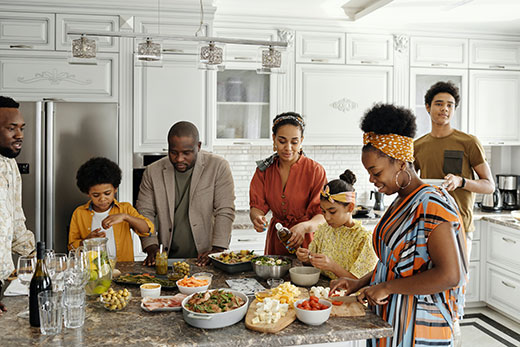
More American families have been cooking meals at home during the COVID-19 pandemic. Food safety specialist Karen Blakeslee shares tips for keeping everyone healthy.
Cozy in the Kitchen: 70% of Americans preparing majority of meals at home
K-State’s Blakeslee shares food safety reminders
Oct. 27, 2020
MANHATTAN, Kan. – It may surprise, well…no one, but consumer surveys are showing that the COVID-19 pandemic has led Americans to their home kitchens more often.
Kansas State University food safety specialist Karen Blakeslee cites a report that 70% of U.S. households are now the central food preparation spot for 80% of meals. In 2019, the same survey found that to be the case in 30% of American homes.
“Cooking at home more has helped to increase family time,” Blakeslee said. “Some have learned to cook new recipes and some have learned new hobbies, such as baking. Others have found new culinary ingredients – such as seasonings – and have created new meals for their families.”
According to a review of data by the Institute of Food Technologists, the most common recipes searched on the internet include banana bread, pancakes, chicken, pizza dough, brownies, crepes, meatloaf, French toast, lasagna and cheesecake.
Some other trends include:
- Millennials and Gen Z consumers are learning new cooking skills and discovering new passions by experimenting in the kitchen, particularly with new seasonings.
- Slow cookers are used in 9 of 10 households and pressure cookers are in half of consumer’s kitchens.
- Eight in 10 who have taken up baking say they will continue to do so even after the pandemic is past.
For Blakeslee, the increase in home cooking is also a cue to highlight the importance of preparing food safely.
“Remember the four core steps for success,” she said. “Clean, Separate, Cook and Chill.”
In order:
- Clean. Wash your hands and clean as you go to keep countertops and equipment clean through meal preparation.
- Separate raw foods (such as meat) from ready-to-eat foods. Clean or use separate utensils when going from raw foods to ready-to-eat foods.
- Cook foods to proper temperatures for doneness. Three temperatures to remember include 145 degrees F for steaks roasts and chops; 160 F for ground meat; and 165 F for poultry.
- Chill foods promptly to reduce the growth of bacteria. Keep hot foods hot and cold foods cold.
Food pantries
Blakeslee also advises care for those who are planning donations to food pantries during the upcoming holiday season. Guidelines for consumers are available online in the K-State Research and Extension publication, Donating Safe and Nutritious Food to Food Pantries and Soup Kitchens.
“Food donations should be handled safely, always looking for signs of damage or contamination,” she said. “Food pantry shoppers deserve safe and nutritious food.”
“Some food pantries may have a list of items to consider donating, or they may have online shopping options to consider. Contact your local food pantry for more information; it doesn’t help to donate something that is not needed.”
Blakeslee also encouraged volunteers at pantries to follow local guidelines, including washing hands regularly, wearing a mask and staying home if they are feeling ill.
More on information on safe food handling is available online from K-State Research and Extension.

